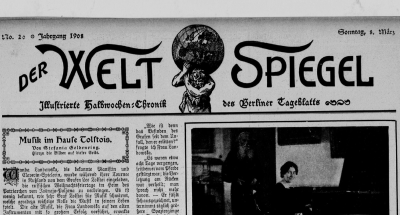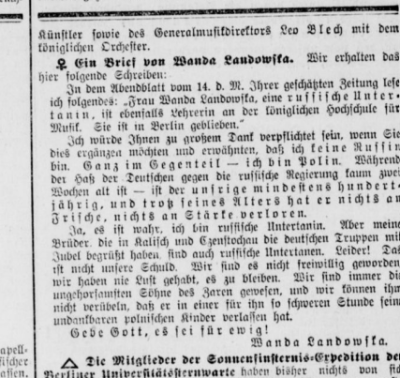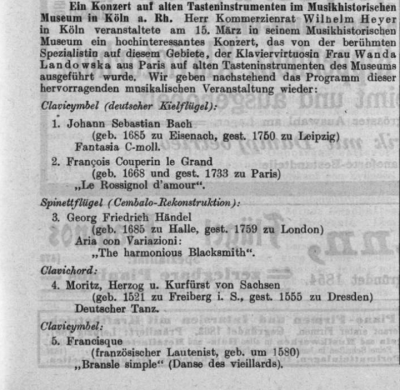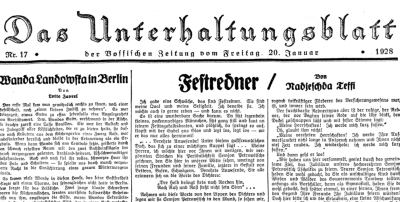Wanda Landowska

In 1899 she made her debut at the Leipzig Gewandhaus concerts with one of the three piano parts in Bach’s D minor concerto for three pianos and strings. In September that year in Warsaw she made the acquaintance of the journalist, actor and ethnologist Henri Lew (1874-1919), who was five years older than she. She decided to continue her career as a composer in Paris, where she married Lew in the following year. Her interest in early music inspired her to join the circle of musicians in Schola Cantorum that had been set up in 1896. The theologian, organist and Bach researcher Albert Schweitzer (1875-1965), who was later to become a missionary doctor and founder of the Lambarene jungle hospital, was also a part of this group. The two kept up an intensive exchange of ideas and opinions on how to interpret Bach’s works.
She began to give recitals on the harpsichord in 1903. With the support of Henri Lew, she studied original sources from the 16th to the 18th century in order to reconstruct fingering, registers, temporal and decorative elements. She also collaborated with the Pleyel firm whose harpsichords she promoted from then on. As time went by her activities as a composer fell into the background. Instead she undertook concert tours of Great Britain, Germany, Switzerland, before returning to Paris and finally in 1907 travelling to Moscow where played at a reception from Russian artists in the Salle Pleyel and met Leo Tolstoy for the first time. In November that year she took her harpsichord to Tolstoy’s house, Yasnaya Polyana (see PDF; Fig.). She visited him once again in 1909, following which she gave recitals in St Petersburg and Moscow. In the same year a 270 page book she had written with Henri Lew-Landowski was published in Paris: it was called “Musique ancienne. Style - Interprétation - Instruments - Artistes”. In 1910 she played at a Bach Festival in Duisburg.
That said, Landowska’s status in the music world was in no way uncontested. Whilst she was in Paris her decision to revive harpsichord music had been received sceptically, because previous attempts to do so had failed on account of the poor quality of the instruments. In her biography she wrote that anyone who heard her as a pianist was worried that she might “neglect the piano in favour of the ‘old joanna’.”[5] And one year after taking up a post at the Music Academy in Charlottenburg, in May 1914 she felt forced to defend herself with an article in the Vossischen Zeitung entitled “The Renaissance of the Harpsichord”; for “it is true that the harpsichord still has many stubborn opponents, but most of these consist of piano teachers and old-style virtuosi”.[6]
When war broke out, Wanda Landowska suddenly found herself classed as an enemy of the state in Germany because she had been born under Russian dominance. Two weeks after the German declaration of war on Russia she was the subject of an insulting article in the Berliner Tageblatt that called her a “Russian subject … at the Royal Academy of Music”. Four days later she answered in a reader’s letter “that I am not Russian. Quite the contrary – I am a Pole. Whilst the German hatred of the Russian government is scarcely two weeks old, our mutual hatred has lasted for at least a century”. (see PDF) The situation appeared to become more normal after the Leipzig Journal Signale für die musikalische Welt and the Tägliche Rundschau spoke out in defence of Landowska and other foreign teachers at the Academy[7].
During the war years Landowska and her husband had a stately residence in the Berlin suburb of Wilmersdorf, in which recitals were followed by a dinner for those present. Rainer Maria Rilke and Gerhart Hauptmann were just two of the guests. Ten years later in the Vossischen Zeitung Lotte Zavrel still spoke of the indescribable dishes, glorious old china tableware, oriental and Spanish dancers and a Landowska, who tirelessly played tangos on her Boston. (see PDF) Everything ended in catastrophe in April 1990. After right-wing groups accused Landowska and her husband of Bolshevik activities Henri Lew was run over by a motorcar not far from their apartment and died. It is unclear whether this was a preconceived murder or not. Zavrel summed things up as follows: “We have lost the most unique salon, one of the central points of international culture.”
Wanda returned to Paris in 1920 and moved into an apartment in the 18. arrondissement. Here Rilke was also one of her guests. She resumed composing and giving recitals, gave lectures at the Sorbonne and master classes at the École normale de musique. In 1921 she undertook a concert tour of Spain, during which she played with Pablo Casals and met Federico García Lorca, Manuel de Falla and Andrès Segovia. In 1923 and 1924 she toured through the USA twice. And in the following year she moved into a house in Saint-Leu-la-Forêt, north of Paris. Two years later she had a concert auditorium built onto the house, which was also large enough to accommodate her constantly growing collection of historical instruments and her library. Here she also gave masterclasses until 1939.
[5] Wanda Landowska: Autobiographical notes, text from a record booklet, 1958, translated from French, in: Martin Elste (publ.) 2010, p. 18.
[6] Wanda Landowska: Die Renaissance des Cembalos, in: Vossische Zeitung, Berlin, No. 259, dated 24 May 1914, reproduced in Martin Elste (publ.) 2010, p.14
[7] Additional documents on this event in Martin Elste (publ.) 2010, p. 74-76.









![„Erinnerungen an Wanda Landowska” [‘Memories of Wanda Landowska’] „Erinnerungen an Wanda Landowska” [‘Memories of Wanda Landowska’] - Poster for the exhibition in the Bachhaus Eisenach, 05/01-11/13/2011.](/sites/default/files/styles/width_100_tiles/public/assets/images/plakat_bachhaus_eisenach_2011.jpg?itok=76h6jPXt)







